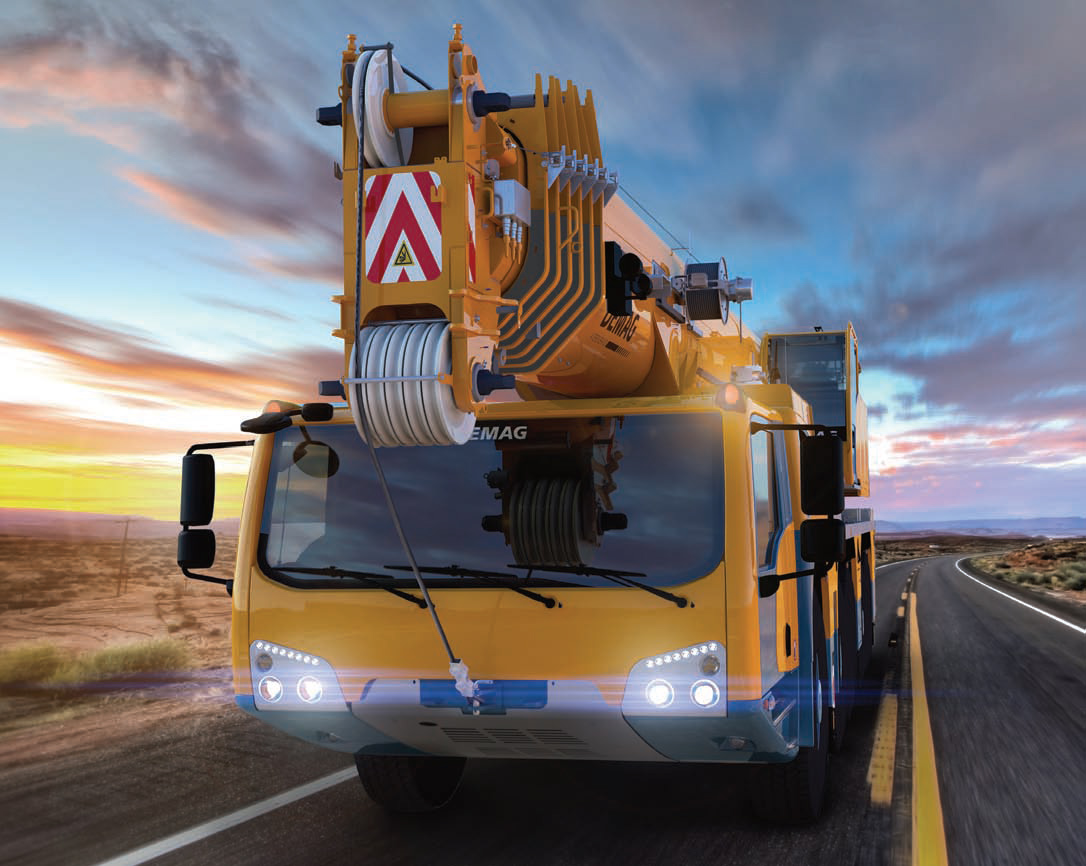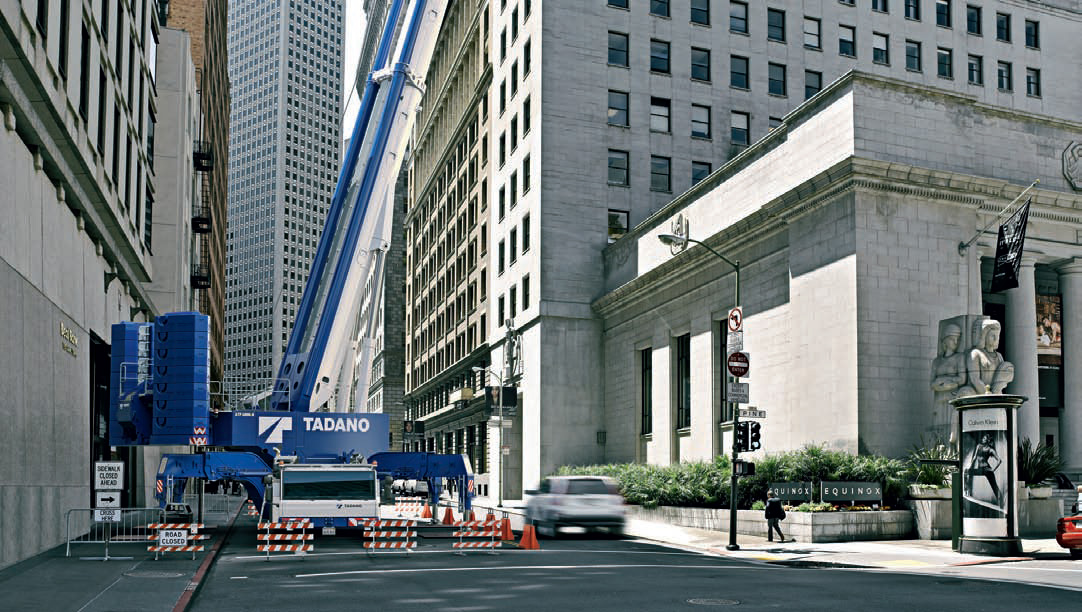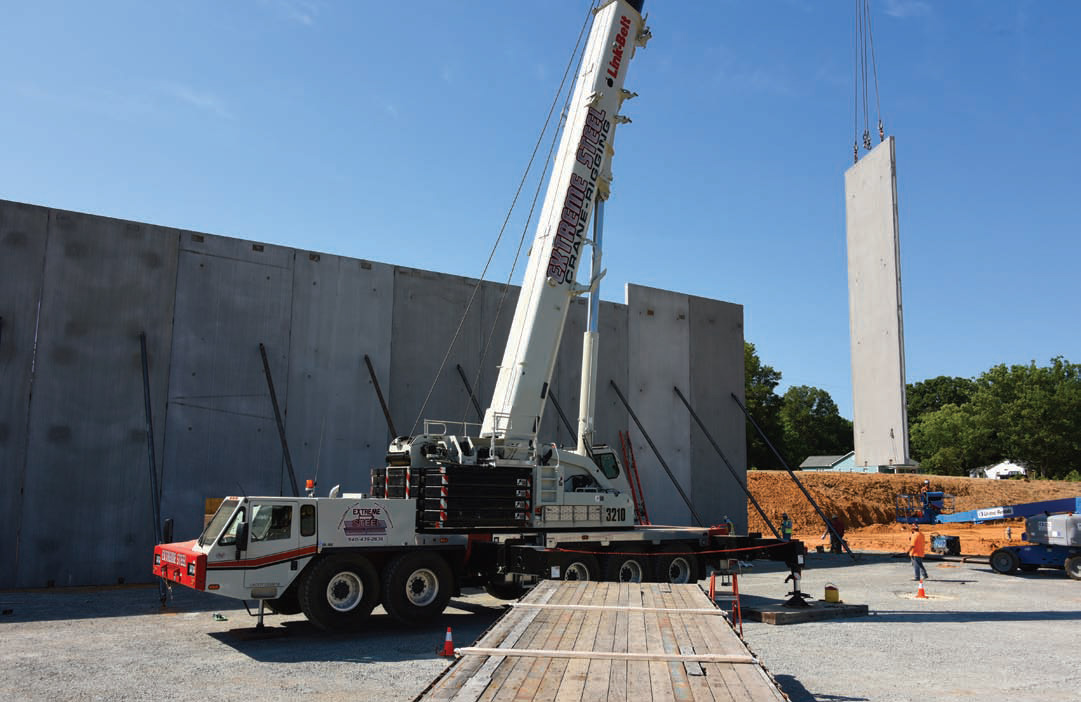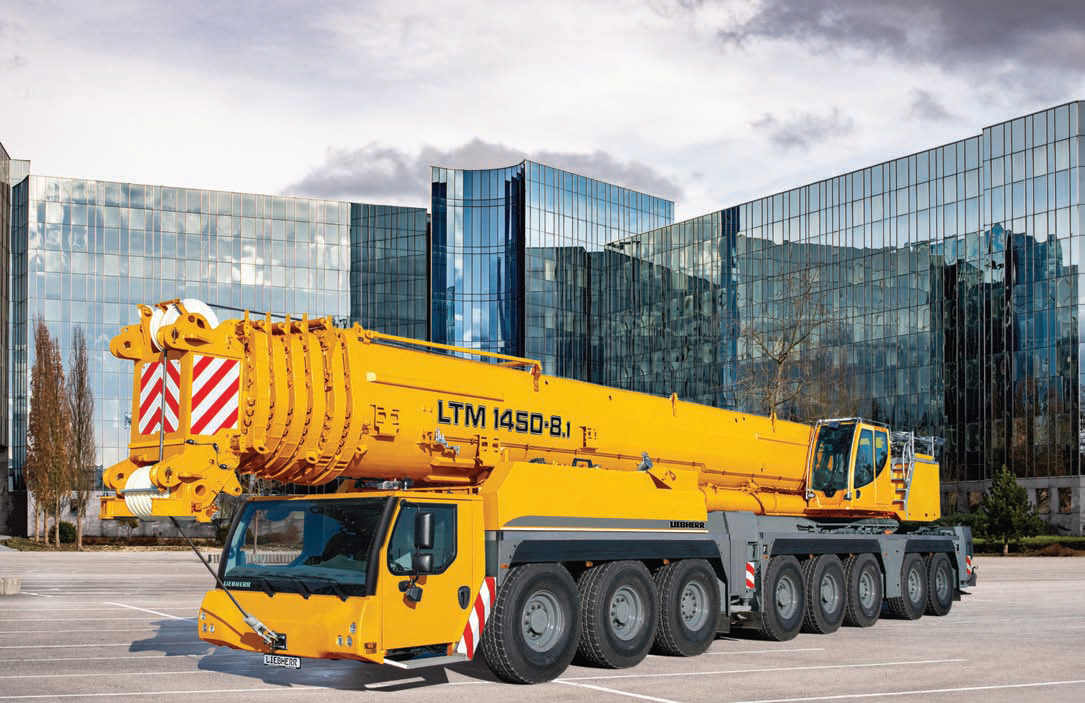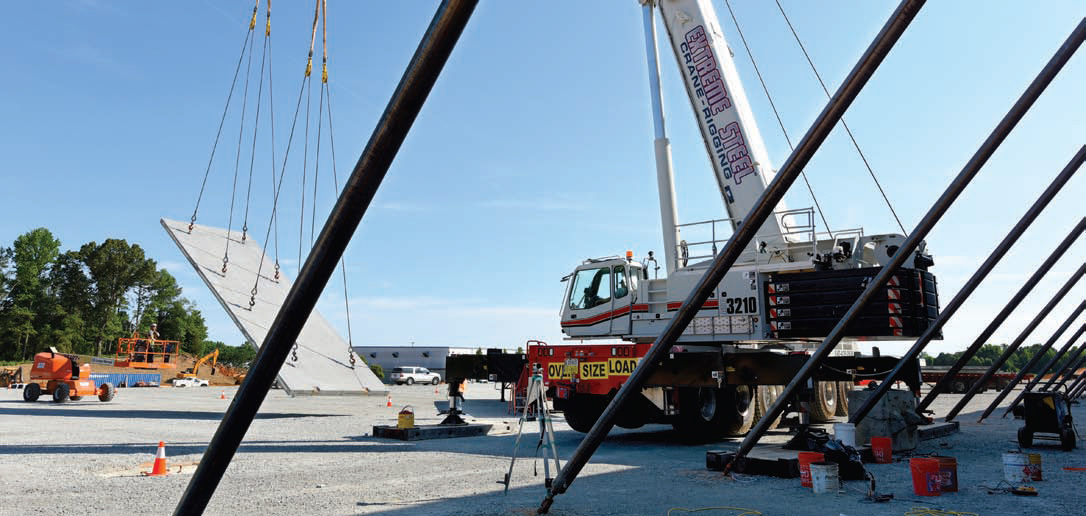Getting off the ground
26 September 2016Terex and Manitowoc have recently upgraded their five axle all terrain lines, while Liebherr and Tadano each have their own very different approach to eight axle cranes. In the US, Link-Belt is seeing a good response to its line of locally-built cranes. Paola De Pascali reports
At Bauma, Liebherr and Tadano both showed new eight-axle all terrain cranes. While Tadano focused on getting the maximum capacity out of a guy-less crane, using its new Triple Boom, Liebherr has developed a ‘maxi taxi’, able to turn up at the job site and lift in the 450t class with a long boom and minimal set-up.
During the show Liebherr revealed the LTM 1450-8.1, which has a maximum load capacity of 450t and an 85m telescopic boom.
“This new model can even perform crane jobs normally reserved for the 500t class in many cases,” says Wolfgang Beringer, head of sales promotion.
This crane has been designed to travel on public roads with a 12t axle load, including its complete telescopic boom and all supports.
This means it can be quickly assembled for use on site.
To support efficient mobilisation around the world, the LTM 1450-8.1 is equipped with a wide variety of transport weights and axle load versions. Beringer says: “A special feature is the VarioBallast which enables the ballast radius to be reduced with infinite adjustment from 7m to 5m using a simple hydraulic system. This is very practical on constricted sites. For example, a ballast radius of 5m is similar to the mobile cranes in the 200t class.”
The LTM 1450-8.1 can hoist 20t at fully extended 85m telescopic boom. “This long telescopic boom is ideal for erecting large tower cranes and for use in refineries and chemical plants,” he adds.
The crane cab is on the side of the boom and does not have to be swung from a driving position behind the boom before working. Beringer says: “This crane doesn’t have a guying system, which usually make cranes stronger.
We refused to provide such system, because it makes cranes more complex and expensive.”
Beringer says the LTM 1450-8.1, has been well-received by Liebherr’s customers. “We sold approximately 20 units during the show. Some customers saw this new model for the first time, but they were so impressed by the economical concept that they ordered it on the same day.”
Tadano showcased at Bauma the ATF 600G-8, which is currently being tested and the company expects to be on the road in 2017.
This eight-axle crane with lifting capacity of 600t, has a main boom of 56m and a boom extension of 90m.
“The key feature of this all terrain crane is the Triple-Boom system, consisting of three telescopic tubes, which give the whole system an especially high degree of flexural and torsional stiffness at all times,” says Uwe Renk, manager marketing at Tadano.
The mass of the total amount of available steel is no longer distributed in just one main boom, but between another two telescopic tubes connected together by “partitions.” These tubes are further away from the centre of the system’s cross-section. The company says this makes the overall system much more stable than a ‘conventional’ single telescopic boom system.
The weight of the new Triple- Boom System is similar to that of a ‘conventional’ boom system, allowing the new crane to comply with the 12t per axle limit imposed in many countries.
The ATF 600G-8 can also bring economic benefits for the crane rental business because without boom suspension there is no need to transport and rig extra components to make the main boom stiffer. The rear tails wing radius is reduced by several meters, so that the crane can be operated in a more confined space or considerably closer to the load.Another new feature is the asymmetric outrigger base control which can be used in any construction site, even in confined spaces. It can allow users to avoid unnecessary lifting capacity losses.
This system uses length sensors to automatically determine the length of all four outriggers, and records the position of the superstructure on the basis of the angle of rotation. These two figures are sent to the crane control system, which then indicates the maximum permissible lifting capacity.
Renk says: “The company opted for two engines because they are beneficial for the crane owner. A big engine is positioned in the carrier and a small engine in the superstructure, which means low fuel consumption during crane operation.”
The ATF 600G-8 can be used in daily jobs in the oil, bridge, building and steel industries. He specifies that although this crane has not been designed for special uses, it can be used for jobs like windmill erections.
Tadano is predicting big savings - several hundred thousand euros - for owners over the first 15 years thanks to economical transport, quick set up and low fuel consumption.
The crane’s small tail swing radius of only 6.95m allows users to perform more tasks in confined construction sites.
The company designed a three stage luffing jib with three different cross sections to transport up to three parts of the lattice jib by sliding them into each other.
The crane owner will no longer need to use a trailer for the boom suspension system. The tripleboom system makes it superfluous, reducing transport costs considerably.
Renk explains how those savings can be achieved: “For instance a truck rental with the driver included, can cost at least €1,000. Considering the average number of jobs for a suspension system per year is 40, we can multiply this number with a 15-year period of ATF 600G-8 use. The result is savings of €600,000 because users don’t need a truck for each travel.” Other costs can be saved, the company says, thanks to the quick set up and easy rigging.
“Our customers are very enthusiastic, it’s a revolution. They would like to buy this machine immediately, but of course they need to wait a little bit,” he says.
The company has already tested the main boom and the luffing jib. “Now, we are testing the tiltable jib and I can say that it’s going well. We will see the ATF 600G-8 in operation in 2017,” says Renk.
Continual improvement Terex and Manitowoc both relaunched five-axle cranes at Bauma, showcasing additional features.
Terex announced the return of the Demag brand, exhibiting three updated five-axle all terrain cranes.
“I am very excited that we are reintroducing the Demag brand. We’re doing it because our customers asked us to bring it back. It is as simple as that,” says Ken Lousberg, president of Terex Cranes. “Demag is a legend and through extensive conversations with our customers, we understand how much the brand still means to them, and what their expectations are that go along with it. It’s a brand they have depended on every day for decades, and it continues to be one of the most recognised brands in the industry”.
The Demag AC 130-5 is the most compact unit in the 130t, five-axle capacity class with a total length of 14.3m and a carrier width of 2.75m. The crane comes with a standard 60m long main boom, but can reach more than 86.5m with additional extensions. When travelling, it is designed to stay under the 12t axle limit while still carrying a payload of up to 450kg.
The Demag AC 220-5 has a capacity of 220t and a main boom of 78m. The AC 220-5 is equipped with a compact frame of 14.5m long and 3m wide for navigating in confined areas. In addition, the crane remains under the 12t axle transportation limit while carrying up to 600kg.
The AC 250-5 model has a total length of 14.5m long and a carrier width of 3m. This 250t machine has a main boom of 70m and the clean axle load, allows the crane to stay under a 12t per axle road limit while transporting up to 550 kg of payload. The AC 250-5 has been designed to offer excellent manoeuvrability with all-axle steering, independent rear axle steering and dynamic launch control.
These five-axle cranes are designed with a single engine concept, which reduces operational cost and maintenance by using an intelligent motor management system to deliver the precise amount of power needed for lifting operations while transporting the crane.
Terex has also equipped these cranes with the IC-1 Plus control system which provides live load chart calculations based on actual crane configuration, including asymmetric outriggers setups. The data from the relevant crane parts, such as counterweight, outriggers, slewing angle, are fed into the control system, the operator simply needs to verify and confirm the data. The purpose of this feature is to improve safety and also to save the time required to program the control system.
The company says that operators can either do jobs with a bigger crane or do the same jobs with less counterweight, because the system can actually use the extra capacity available when lifting over outriggers.
Terex also provides desktop and in-cab lift planning software to make the most of this new system. One more safety benefit that this system provides is a +/- 30° slewing radar, which helps the operator anticipate movements and stay in the safe zone. About the market for midrange ATs, Erwann Maillot, communications manager at Telex says: “Today almost 50% of the AC market are five-axle machines, which are typical taxi cranes that can go out very often without additional transport means.”
He adds: “The five-axle market is still growing in terms of units, but it’s slightly decreasing in terms of total market share as the market moves towards bigger cranes. However, most of the all terrains sold still are of this type. We expect that the five-axle market will be stable over the next years and it will remain a very popular market. The share of the total market will probably stay around 50%.”
Manitowoc exhibited three five-axle cranes at Bauma, the Grove GMK5150, GMK5150L and GMK5250L.
The GMK5150 replaces the GMK5130-2 while the GMK5150 is an updated version of the GMK5110-1.
These all-terrain cranes have been designed to offer the best load charts in their class, both when working in their taxi configuration and when configured with their maximum counterweight for optimal capacity.
The GMK5150 and the GMK5150L both have a capacity of 150t and the length of their booms is 51m and 60m respectively. Up to 10.2t of counterweight can be carried by the GMK5150 in its taxi configuration with a gross vehicle weight of less than 12t per axle.
The GMK5150L can accommodate up to 7.9t of counterweight in its taxi configuration.
With a capacity of 11.6t when its boom is fully extended to 60m, the GMK5150L can be used for tower crane assembly or other applications where strength at height is required.
Boosting both cranes’ overall reach is an 18m bi-fold swing-away jib, which can be increased to 34m with an 8m boom extension and an 8m jib extension. The jib also offers an improved offset of 50°.
Jens Ennen, senior vice president for mobile cranes in Europe and Africa at Manitowoc, explains that the key features of the GMK5150 and the GMK5150L improve mobility, reach and capacity.
“For several years we’ve been launching all terrain cranes out of our factory in Wilhelmshaven, Germany, that have set new standards in the industry,” he says. “With class-leading load charts and specifications, the new GMK5150L and the GMK5150 are highly mobile cranes that continue this tradition. In addition, these cranes will maximise return on investment for our customers through their superior reliability and ease of transportation.”
Powered by a single engine, the overall weight of these allterrain cranes has been reduced so that they can carry more counterweight. The engine is a Tier IV Final/Euromot 4 Mercedes- Benz OM471LA six cylinder diesel engine with a 390 kW rating at 1,700rpm and a maximum torque rating of 2,460 Nm at 1,300rpm. With 16-inch tyres and an overall width of 2.75m, the cranes can be easily manoeuvred on congested job sites.
Operator efficiency is maximised through the inclusion of Manitowoc’s crane control system (CCS), a standardised and user-friendly interface whose components and operating software have been designed to ensure the highest standards of reliability.
It includes the boom configurator mode, which makes it easy to select the optimum boom position for a specific lift. The operator inputs lift parameters such as radius, load or required distance the boom should be moved, and the system calculates the best configuration. Once the operator selects the preferred option, the boom automatically extends to the required length.
Andreas Cremer, global product director for all terrain cranes at Manitowoc, says: “We didn’t increase the boom length, but we increased the load chart by 20%.
At the same time we made the machine lighter to guarantee better roadability for the global market.”
The appearance of the GMK5150 and GMK5150L changed compared to their predecessor cranes, as they have a new ergonomic Mercedes carrier cab. All the trademark Grove features such as the twin-lock boom pinning system, Megaform boom shaping and Megatrak independent active suspension are included.
The manufacturer says that its laser-hybrid welding technology increases welding precision, creating booms that both weight less and perform better.
Deliveries of the new GMK5150 and GMK5150L will start in the fourth quarter of 2016.
The Grove GMK5250L has a capacity of 250t and it was introduced in April 2015, which was followed by the launch of the GMK5180-1 and the GMK5200-1 in July. “We wanted to get ahead in this crane segment by re-launching these models with new features,” says Cremer.
Among the GMK5250L features is the VIAB turbo clutch and integrated retarder. The VIAB module eliminates both fluid overheating and clutch burning, and delivers wear-free starting and braking and better fuel economy.
Fuel usage for the GMK5250L is estimated to be up to 30% lower than its predecessor, the GMK5220.
The length of the main boom is 70m. For optimum usage, the full jib can also be operated while the crane is working with its full boom.
Another benefit is the ability to offset the jib by up to 50° compared to 40° on other Grove cranes. An optional integrated heavy-duty jib is also available.
Like the GMK5150/5150L, the GMK5250L has CCS with boom configurator mode and power is delivered via a Tier IV Final/EUROMOT 4 Mercedes-Benz OM471LA.
The gross vehicle weight has been reduced to give customers more transportation options, including the ability to carry more equipment. Special attention has also been paid to the axle group spacing, which exceeds 2.4m. This is a strict requirement for North America.
Once on the job site, the crane can be moved with its full counterweight of 80t, saving valuable time that would otherwise be spent installing or removing counterweight sections. An optional self-rigging auxiliary hoist eliminates the need for a second crane during on-site rigging. The GMK5250L was launched in the middle of last year, and the first units have already been delivered to customers.
Cremer says: “The Grove GMK5250L can also be used for tower crane rigging. The benefit of having a long boom is that you can go on the jobsite and telescope the boom without rigging any jibs to get higher.”
“As the mobile crane industry evolves, we want to lead the way in showing our customers how our innovative designs can deliver better financial returns for them,” says Ennen.
Cremer says that there is strong demand for 100/150t crane and 200-250t cranes. “Many of our customers have these machines in their fleet and use them in taxi configurations. We delivered the first GMK5250L in October 2015 and at the moment this is the most successful model. The company designed this machine for the global market, so we sold units in North and South America, Europa, Asia and Africa.”
Highway ready Link-Belt’s all terrain range includes two models, the ATC-3210 with a 210USt capacity and the ATC- 3275 with a 275USt capacity. Both models are designed to have impressive reach, strong capacities, and outstanding mobility on the road and jobsite.
The ATC-3210 can travel at highway speeds of 62mph, and be transported with three overflow loads. The company says the hydro-gas suspension can benefit manoeuvrability on the job site and travel on the road.
The ATC-3275 all-terrain crane shares some key features with the ATC-3210. It has a sevensection pin and latch boom as well as eight boom extend modes.
Both all-terrain cranes can be configured to meet some of the toughest transportation standards, compliant with the highest emission requirements.
Grease points have been minimised with greaseless boom and transportability has been a design priority. Maximising loads and minimising the number of support trucks both translate into real cost savings.
Link-Belt’s in-house designed Link-Belt Pulse system has set a new standard as an easy to use, reliable, and accurate crane operating system. This system includes the rated capacity limiter, boom extend mode controller (EMC), self-diagnostic capabilities and continuous monitoring of multiple crane functions and conditions. In order to aid operators in safe operation, its high-resolution graphic display can deliver a contrast even in direct sunlight.
Patrick Collins, director of product marketing explained, “We have a strong presence in the all terrain market because both the ATC-3210 and ATC-3275 are ultra friendly to transport, simple to operate, and have great capacities.”
He adds: “Our customers expect us to expand our all-terrain crane line and we will not disappoint.
There will be more to come to satisfy the needs of our customers.”
Collins also outlines the background to Link-Belt’s development of its own all terrain product line. “Our success started with truck cranes in the early 1990s. We really focused on developing truck crane features that made transport quick and easy, by simplifying set up and tear down for the cranes. This philosophy quickly put Link-Belt into the leadership position in the truck crane segment. By the early 2000s we had a brief partnership with Tadano-Faun to offer their product for the North American market.
“It became clear through the years that we needed to be in control of our own destiny,” says Collins. “There were two key elements of manufacturing all-terrain cranes that weren’t within our control: transport and complexity of the crane. Our engineers and marketing experts determined that there was a void in the all-terrain crane market in North America.”
He underlines that Link-Belt needed to build all terrains to comply with tough local transport regulations.
“We wanted to achieve several elements for the crane owners - designing and manufacturing all terrains that had to be friendly with North American transporter loads.” The next major step was to build the facility for all terrain assembly, manufacturing all the major elements in Lexington, Kentucky.
Therefore Link-Belt started this business venture, achieving success in specific applications such as crane rental houses.
“Crane rental houses are an automatic fit for our all-terrain cranes because of their necessity for quick setup and tear down,” explains Collins. “If you truly have the best machines for mobilising and demobilising a crane, along with a competitive chart, you can do very well in that segment of the business. For example, we realised that there was untapped demand particularly on the East Coast and we have done very well with the ATC-3210 in that market.”
